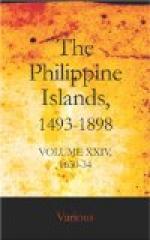In 1629 Fray Juan de Henao becomes provincial, at which time arise various controversies in the order. To settle one of these, an envoy is sent to Rome, Fray Pedro Garcia; but he dies before reaching Nueva Espana. The archbishop of Manila is carried away by a fever; Medina eulogizes his virtues and ability. He gives an account of the unsuccessful expedition against the Joloans, led by Olaso; it “returned to Manila the laughing-stock of all the islands.” The burdens imposed on the Indians for its equipment have occasioned much distress and many deaths among them; and its failure causes those of Cagayan to talk of revolt. The year 1630 is unusually stormy, and all the ships on the Acapulco route suffer disasters and loss of life. Religious are unwilling to risk their lives in crossing the Pacific, and the missions in the islands suffer accordingly. A ship built at Cavite is so poorly constructed that it partially capsizes at the time of setting sail, by which great loss of property and life ensues. Medina is so fortunate as to escape to shore—one of many like deliverances, which he proceeds to recount, as also a miracle performed by the “Santo Nino” at Cebu.
The persecutions in Japan still continue, yet religious go thither in disguise, at the risk of death. An expedition is sent out from Manila to capture any Dutch vessels that may be encountered on the coasts of Siam and Camboja. Their destruction of a Japanese junk occasions various embassies between the Philippines and Japan—the last of these in 1631, desiring to resume trade between those countries. This and some other occurrences in that year seem to have been added later by Medina to his manuscript, which purports to have been written in 1630. In 1629 an expedition is fitted out by the religious orders to send missionaries to Japan, but it proves a failure. The canonization of Japanese martyrs is the occasion for magnificent spectacles in Manila—processions, dances, comedies, etc. Irritated by harsh treatment from an arrogant Spanish officer, the Indians of Caragan revolt, killing the Spaniards, among whom are several missionaries; but troops from Cebu are sent there, and quell the rising.
Resuming the miscellaneous documents of that period, letters are sent to Manila (December, 1630) by the king regarding various matters that have been referred to him. Felipe orders that certain offices shall be sold; that the natives must pay at least part of their tributes in kind; and that the salaries of the auditors be more promptly paid. Command is given that war-ships in the islands be no longer built so large as hitherto, as they are expensive, unwieldy, and in some circumstances useless. A letter to the auditors gives directions for the method of procedure in trying certain cases of appeal; and answers some questions which the auditors had asked. Bishop Arce, of Cebu, writes to the king (July 31, 1631). He congratulates Felipe on the birth of a son; comments on some royal decrees just received; recommends a person as schoolmaster in the Manila church; and advises the appointment of the royal fiscal as protector of the Sangleys.




